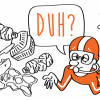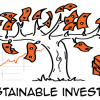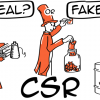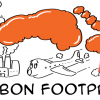Transcript
6 unexpected connections between Coronavirus and Environment
Hi, Alex here. As you can probably imagine, I have been thinking as much about the current pandemic as sustainability recently. And then, I started connecting the dots between the two. Today we are going to talk about white-footed mice, speaking trees, opossums, humans and we will look at 6 unexpected ways the coronavirus is connected to sustainability, the environment and climate change. Ok, let’s get drawing!
When the coronavirus crisis started, I discovered, like many of you, this graph. Essentially, our primary goal quickly became to have fewer cases than our health care system capacity could take. And then people started saying “Hey, can we flatten that curve too?”, using the crisis to get people’s attention on climate change. I thought that was clever. But the part that I found most interesting, is that even if these 2 curves represent the same number of people who eventually get infected, in the slower scenario, fewer people die. And this is exactly what sustainability is about. Even if the amount of used natural resources is the same, in the sustainable scenario we are using them at a rate that causes fewer casualties (animal life, ecosystems, people and otherwise). In other words, it is meeting human needs within ecological constraints.
Let’s look at our ecological footprint for instance. Here is the graph: it is about using only one planet whereas we are currently using 1.7 planets. Even if we are using the same amount of resources, in the good scenario, we are living off the interest, in the bad scenario we are digging into our natural capital. This footprint perspective is also interesting because it is precisely our encroachment on nature that increases the risk of a pandemic. In this Vox article, Sonia Shah, author of the 2017 book Pandemic, explains that “when you cut down forests, bats don’t just go away. They come roost in the trees in your backyard or farm which means it’s easier to have casual contact with their excretions. With Ebola, the first case was a 2-year-old child in West Africa who was playing near a tree where bats live”. It is also why there has been outbreaks of tick-borne disease like Lyme in the northeast of the US: when the forests were intacts, opossums and chipmunks controlled the tick population. Now 50 years later with fewer forests, there are fewer opossums and chipmunks and more white-footed mice and deer but the mice destroy only about 50 ticks a week when an opossum destroys several hundred just by grooming. We live in a complex system and our actions have an impact. My video on the story of the cats in Borneo is another example.
As mentioned at the beginning, flattening the curve also means keeping our CO2 concentration under 350 ppm or the 1.5°C decided at the Paris agreement. It does not mean we can’t produce CO2, it means that when we produce CO2 at such a rate that nature can process it, it does not impact the planet and people nearly as much. With the coronavirus probably coming from a wet market, it is tempting to look at our meat consumption, isn’t it? We know the amount of meat we eat is a great contributor to climate change: 25% of greenhouse gas emissions are attributed to agriculture and around 15% are attributed to meat production and livestock (this is as much as the emissions attributed to all transportation by the way). More often than not, the animals are packed very close together to increase profit. And guess what, according to Sonia Shah again, two of the most dangerous threats of a new pandemic (highly drug-resistant forms of bacterial pathogens and virulent avian influenza) are both driven by the crowding in factory farms. Well, I call that that a great opportunity to fix two major problems at once, what do you think? This closes the loop on the deforestation we mentioned earlier as cattle ranching is one of the main reasons for the destruction of the Amazon rainforest: at current rates 25% of Amazon will have no trees by 2030 according to WWF and the forest will stop being a carbon sink in 2035.
This brings us to our next point: just as the capacity of the healthcare system can fall as healthcare practitioners get sick during a pandemic, climate change and degradation of nature also decrease the capacity of the earth to sustain us. This is called a positive feedback loop (although it does not not do anything positive to us in this case). We already know that, as glaciers melt, their reduced white surface reflects less of the heat coming from the sun, further increasing global warming. In a recent study published in the journal Science, Tim Brodribb reviewed the last 10 years of research on tree mortality, and concluded that “most trees alive today won’t be able to survive in the climate expected in 40 years.” He says, with a microphone, you can hear them take their last laboured breaths. This could mean less capacity to absorb our CO2 emissions, more wild animals coming to our backyard and more potential risks for pandemics. Another good reason to address climate change and systematic degradation of nature right away. As I explained in a previous video using a funnel metaphor, the more we wait, the less margin to maneuver.
As US biologist Thomas Lovejoy pointed out in a recent Guardian article “this is not nature’s revenge, we did it to ourselves.” Nature is sending us a message and the COVID-19 crisis has created a great opportunity to change some of our practices and to look at how we live and work in better partnership with nature. Paradoxically, the pandemic also results in a significant cut in emissions worldwide (an estimated 5.5% drop in carbon dioxide emissions would be the largest yearly change on record) and great improvement in air quality in many large cities. Can we resist the temptation to jump back to our failing system as soon as the pandemic fades out and instead create the systems that the future requires of us? Please let me know what you think in the comments down below.






